Introduction
In general, military crises will always impact and affect people’s lives in one way or another. The assets are destroyed during them; production, marketing, and consumption processes are hampered; the natural resources are used improperly; the “cost of life” is increasing; the value of the money supply decreases due to inflation; it increases the degree of insecurity of civilians, and life expectancy becomes reduced (Gewehr and Guerra, 2022).
All these consequences manifest in different intensities, individually or simultaneously, depending on the type of military crisis unfolding. For example, military crises caused by some terrorist attacks generate consequences that manifest themselves for a relatively short period, and the resulting shock wave only affects people’s lives punctually (Baumert et al., 2020; Herzenstein et al., 2015).
But, when military crises occur caused by a war, the situation changes radically.
War is a simple word for a very particular and complicated situation. War is a fight between the armies of two or more countries (Blattman, 2022). It lasts long and can be carried out on land, sea, or air (Dudziak, 2012). In the end, the winning country will increase its power and influence, expand its territory, or protect itself from the attack from the enemy country (Goodhand, 1999; Horowitz et al., 2015).
War is the most complex military crisis and has the most significant and comprehensive repercussions (Pandey et al., 2023). When a war occurs because of its specificity and the way it manifests, a lot of damage is caused, such as the destruction of existing infrastructure, turning farmland, forests, villages, and cities into battlefields; the mode of operation of the economy of the involved states changes into a war economy and, last but not least, large amounts of financial resources (money, goods and objects) are consumed, or many human lives are lost (Kemmerling et al., 2022).
The consequences of a military crisis stem from the lack of consideration and treatment of civilians who are not directly involved in the conflict (Dudziak, 2012) because those who lead and coordinate the armies focus more on the context provided by battle coordinates and military objectives and less on the lives of ordinary people (Koopman, 2011).
The Impact of the War in Ukraine on the European Union and on South Korea – Literature Review
February 24, 2022, can be considered a turning point in recent world history.
At the beginning of 2022, the economic, medical, social, and political effects of one of the biggest crises in history, the COVID-19 pandemic, were still felt globally (Ørskov et al., 2021). But, the end of February put humanity in front of a new crisis, a crisis caused by the war started by Russia against Ukraine. Thus, from that moment, world leaders had to face and find solutions to solve the problems generated by another crisis (Anghel and Jones, 2023; Ørskov et al., 2021).
Predicted by the annexation of the Crimean peninsula in 2014 (Lucas, 2014; Olszański et al., 2014), and also by the events of late 2021 and January 2022 (deployment of troops on the border with Ukraine and in Belarus), Russia began a war on the territory of Ukraine, on the eastern edge of the territory of the European Union.
Russia’s reason behind this decision was not a military one, but it was the idea of saving the Ukrainian people from the process of “denazification” and “demilitarization” through a military action carried out by the Russian army on the territory of the country with the capital in Kyiv (Abay et al., 2023; Kazdobina et al., 2024).
In this way, Russia in the 21st century created a new military crisis with far-reaching effects regionally on the “old continent” or even globally (Ahmed et al., 2023; Ben Hassen and El Bilali, 2022; Tong, 2024).
The European Union (EU) and Russia have had excellent economic and trade relations (European Parliament, 2023). These relations have made Russia one of the EU’s most important trading partners. By 2021, Russia was the EU’s fourth and fifth most significant trading partner (Table 1; Figures 1 and 2) (European Parliament, 2023).
Table 1: Top 5 import and export partners of the European Union in 2021
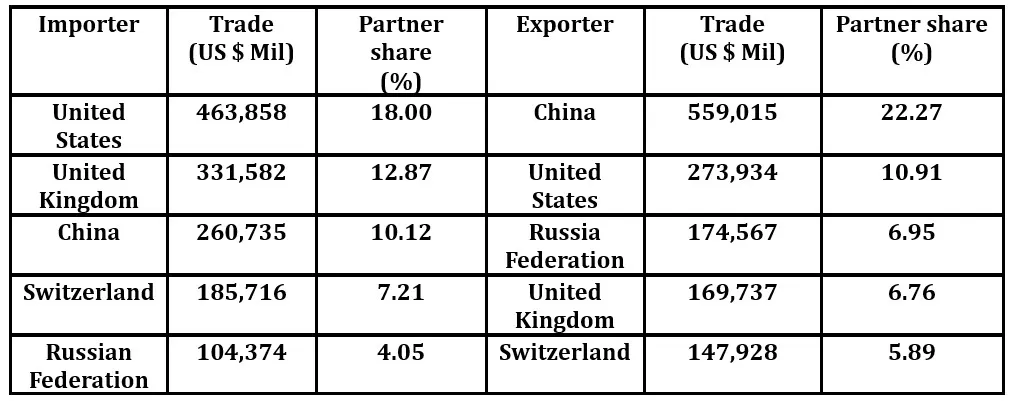
Source: World Integrated Trade Solution (WITS), 2024

Fig 1. EU-Russia/Russia-EU exports from 2000-2021
Source: World Integrated Trade Solution (WITS), 2024

Fig 2. EU-Russia/Russia-EU imports from 2000-2021
Source: World Integrated Trade Solution (WITS), 2024
Also, the positive results of this partnership have materialized through the EU’s support and help to Russia in its accession to the World Trade Organization (WTO) since 2012.
However, the EU-Russia relationship began to suffer in 2014 due to Russia’s behavior and actions in Ukraine.
Then, Russia’s annexation of the Crimean peninsula caused the EU-Russia economic-diplomatic partnership to have a series of negative consequences, but these consequences were not very significant in the economic and commercial relationship (European Parlament, 2023). On the other way, since 2016, the EU has reassessed, revised, and redefined its financial, commercial, and diplomatic relations with Russia by adopting the policy called “EU Global Security Strategy” (European Union Global Strategy, 2016).
From the moment Russia attacked Ukraine and started a war on the territory of this country, the EU radically changed its strategy and dialogue with and towards Russia, verbally condemning its behavior, saying that it is targeting the security, integrity, and values of the alliance and classifying it and considering it “a direct threat to European security” (European Parlament, 2023).
Furthermore, the European Union, led by Ursula von der Leyen, President of the European Commission, demonstrated unwavering solidarity with Ukraine. It promptly offered economic and military aid (excluding the deployment of troops) to the country that shares a border with the EU. The EU also assured this support would persist until Russia’s aggression was quelled (European Parlament, 2023).
In this direction, the EU adopted a series of economic measures called “sanctions packages” through which it economically and commercially sanctioned Russia’s slippage (European Commission, 2024). In this case, thirteen such “sanctions packages” on Russia were adopted by the EU from the beginning of the war until the end of 2023 (European Commission, 2024). By adopting these “sanctions packages”, the EU publicly condemned the crimes committed by the Russian military, the annexation of the Ukrainian provinces of Donetsk, Luhansk, Zaporizhia, and Kherson, tried to destabilize the Russian economy, and, last but not least, tried to sanction the most powerful Russia’s allies, Belarus and Iran, because these two states support Russia and help to continue the war (European Commission, 2024).
As expected, the change in the EU-Russia relationship and the existing problems due to the COVID-19 pandemic (Prohorovs, 2022) caused other new adverse effects. These effects spilled over and affected the behavior of Europeans as citizens, especially as consumers, as seen in Figure 3, Figure 4, and Figure 5 (Liadze et al., 2023).

Fig 3. Economic relations between the EU and Russia between January 2021 and December 2023
Source: Eurostat, 2023

Fig 4. Evolution of the Harmonized Index of Consumer Prices (HICP) in the European Union (EU) in the period 2019-2023
Source: Eurostat, 2024a
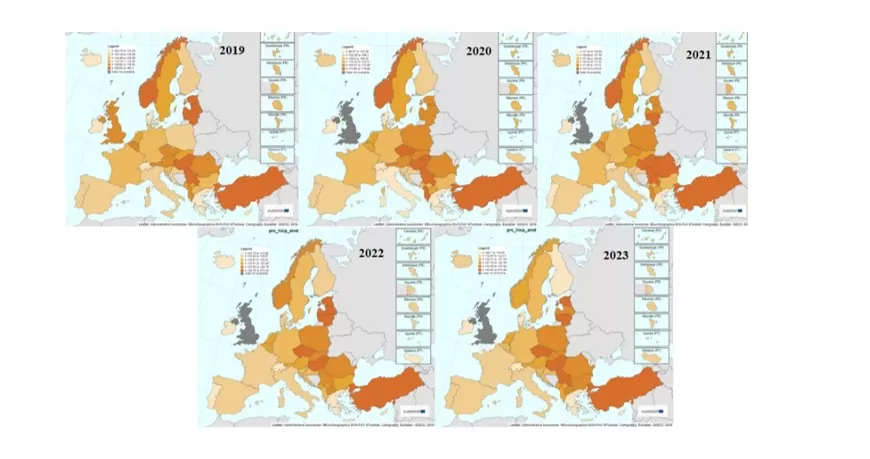
Fig 5. Evolution of the Harmonized Index of Consumer Prices (HICP) in European and European Union (EU) countries in the period 2019-2023
Source: Eurostat, 2024
So, from 2022, the EU-Russia economic and commercial partnership almost ceased to exist, and the citizens of the European Union felt that consequence.
As the European Union (EU), South Korea, one of the world’s most civilized, educated, and influential countries (Ministry of Foreign Affairs, 2024), was affected by the war in Ukraine.
Similar with the EU-Russia partnership, South Korea and Russia have had an excellent partenership and very strong diplomatic relations over time (Figure 6 and Figure 7) (Heo and Roehrig, 2014; Roehrig, 2022). The two states considered these relations a “strategic cooperation partnership” (Lukin, 2018; Roehrig, 2022).
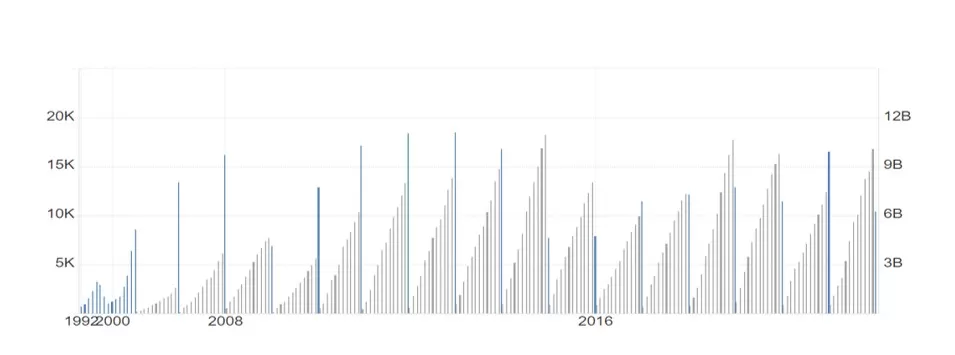
– South Korea exports to Russia – Russia exports to South Korea
Fig 6. South Korea – Russia and Russia – South Korea exports
Source: Trading Economics, 2024
– South Korea imports to Russia – Russia imports to South Korea

Fig 7. South Korea – Russia and Russia – South Korea imports
Source: Trading Economics, 2024
Since 2022, when Russia started the war against Ukraine, relations between South Korea and Russia have changed radically.
When the Kremlin regime annexed the Crimean peninsula, part of Ukraine, in 2014, the connection between the two states did not suffer (Heo and Roehrig, 2016; Sang-ho, 2014); but the situation was not similar in 2022 (Tong, 2024).
Similar to the reaction of the president of the European Union, the President of South Korea condemned Russia’s actions, expressed public regret for the attack on Ukraine, and demanded an immediate end to this conflict and its solution through peaceful means (Kim, 2022). Also, South Korea admitted that Russia violated Ukraine’s sovereignty and international regulations and laws (Varaki, 2022).
In addition, the Moon administration also stated that these events disturb stability and peace worldwide (Smith and Shin, 2022) and do not resonate with the democratic values promoted and found in the free democracy of South Korea (Varaki, 2022).
It must be mentioned that contrary to what South Korea claimed and promoted, this country did not apply sanctions measures to Russia from the beginning of the war in the same way as the EU did (Roehrig, 2022). Also, South Korea does not apply the same measures even two years after the start of the war (Stangarone, 2024).
The main reason that was behind and caused this position of South Korea in terms of sanctioning Russia was generated by the fact that the Asian country tried to maintain stable and relatively safe relations with North Korea through Russia, which was the principal mediator of the dialogue between Pyongyang-Seoul (Roehrig, 2022).
Thus, South Korea avoided acting and sanctioning Russia because it categorized and considered what was happening in Ukraine to be only a regional conflict, and the effects would not be very significant (Smith and Shin, 2022).
So, South Korea was very afraid that Russia could bring weapons and military technology to North Korea, and on this occasion, with Moscow’s support, Pyongyang could start a new war against them (Kuhn, 2022). This fear led them to a different position about Russia’s behavior.
But then because of the pressure from the United States of America (their main ally), the pressure from the Moon administration’s opposition, and the pressure generated by the citizens who had already donated millions of dollars to the Ukrainian embassy in South Korea to support the Ukrainian people economically (Kim Na-Young, 2022; Roehrig, 2022), the South Korean government changed its position (Oh, 2022).
So, in the end, the executive of South Korea was caught somewhere in the middle, and, knowing that no matter whose side he took, he would suffer (Kim, 2022), he decided to support Ukraine, only with non-lethal non-military aid, such as food for soldiers, bulletproof vests, military medical kits, helmets, etc. (Da-gyum, 2022; Roehrig, 2022). At the same time, the Asian country also offered to Romania, Hungary, Poland and Slovakia essential sums of money and humanitarian aid to deal with the migrant crisis in Ukraine (Ministry of Foreign Affairs, Republic of Korea, 2022).
Similar to the change in the EU-Russia relationship and the change in the South Korea-Russia relationship, along with the existing problems caused by the COVID-19 pandemic (Prohorovs, 2022), these two events generated a series of issues and consequences that affected the behavior of people from South Korea from the perspective of citizens and consumers, as seen in Figure 8, (Roehrig, 2022).

Figure 8: Evolution of the Harmonized Index of Consumer Prices (HICP) in South Korea in the period 2019-2023
Source: Trading Economics, 2024b
In this context, Russia was not indifferent to the reactions from the EU and South Korea and responded extremely quickly to the decisions of the two economic and commercial partners and, in turn, changed their trajectory (Kim, 2022). Thus, Russia made public a list of foreign territories and states unfriendly to its actions and behavior, including the European Union, the United States of America, Canada, Australia, Japan, and South Korea (Tereshchenko, 2022).
At the same time, Russia emphasized that the military, economic, and diplomatic relations between Russia and North Korea will strengthen, testing the security of the Korean peninsula and the security of the NATO alliance (Choi Soo-hyang, 2022; Kim, 2022). Therefore, Russia, wich is an essential energy supplier of the EU, a vital energy supplier of South Korea (The Observatory of Economic Complexity (OEC), 2024), and one of the most important economic partners of both states (European Parlament, 2023; Haggard, 2022), and also South Korea’s most important diplomatic partner in the relationship with North Korea (European Parlament, 2023; Haggard, 2022), has partially broken economic and trade ties with the EU and with the Asian country.
This article aims to observe and analyze the impact of the outbreak of the war in Ukraine from February 2022 to December 2023 on the behavior of consumers in the European Union compared to consumers in South Korea from the perspective provided by a comparative analysis of the evolution of the consumer price index for food and non-alcoholic beverages and consumer price index of energy using Difference-in-Difference (DiD) statistical technique.
This analysis is necessary because we can observe and understand the effects of a military crisis caused by one country (Russia) on two countries with which it shares a common border (the EU and South Korea) and with which it has had excellent economic and commercial relations over time.
At the same time, this research is also necessary to see how citizens as consumers have been affected by the effects of the different policy approaches taken by the EU and South Korea regarding how they have imposed and implemented sanctions. If the EU currently has only formal diplomatic relations with Moscow, South Korea still undertakes economic relations with the Kremlin and currently purchases fossil fuels (Figure 9) and other energy products from Russia (Stangarone, 2024).
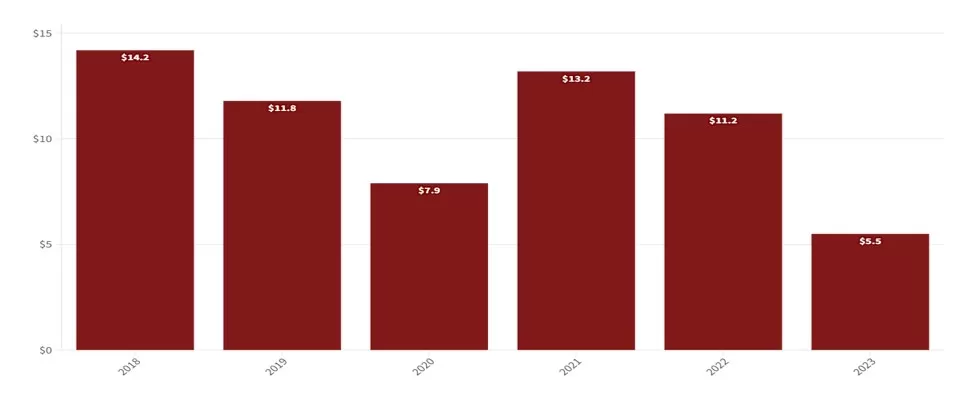
Figure 9: Value of imports (US $ Mil) of fossil fuels of Russian origin by South Korea
Source: Stangarone, 2024
Methodology
Difference-in-difference is a statistical technique used in econometrics to perform specific analyses in several fields, such as public health, economy, education, or public policies (Huntington-Klein, 2021). This statistical tehnique is used to measure and evaluate consequences caused by an intervention/treatment, such as the implementation of public policies or the manifestation of threats, etc., in an observational or quasi-experimental study, as seen in Figure 10, (Huntington-Klein, 2021).
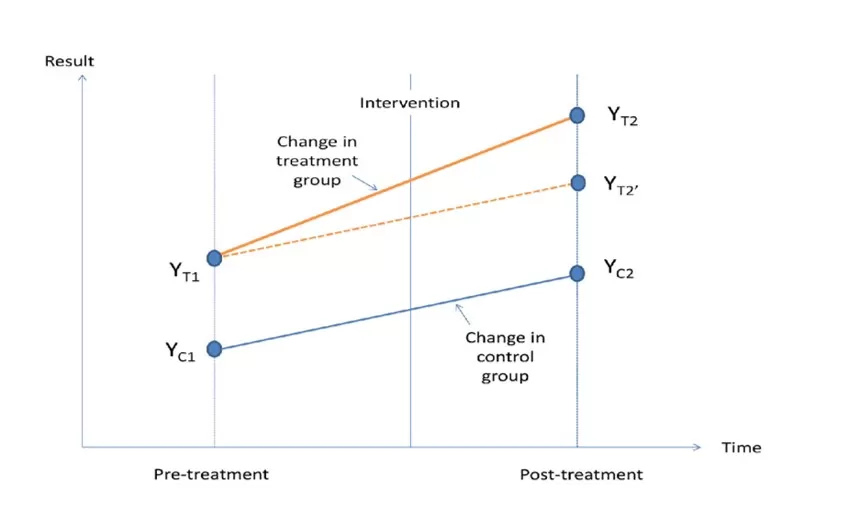
Fig 10: Representation of the Difference-in-Difference (DiD) statistical technique
Source: Morris et al., 2013
DiD uses the regression δDD = (ӮB,2 – ӮB,1) – (ӮA,2 – ӮA,1), and the results are confirmed by using the parallel trends test (Columbia University Mailman School of Public Health, 2016; Huntington-Klein, 2021).
To do a DiD, longitudinal data should be used to obtain a counterfactual result, which allows one to estimate and predict a causal effect. The longitudinal data must be divided into two groups: the treatment group and the control group. Data must be available before the intervention (pre-intervention) and after it (post-intervention) (Columbia University Mailman School of Public Health, 2016; Huntington-Klein, 2021). The result obtained by the DiD statistical technique compares the changes observed at the level of the treatment group that has been exposed to a specific intervention with the changes observed at the level of the control group that has not been exposed to that intervention (Columbia University Mailman School of Public Health, 2016; Huntington-Klein, 2021).
The difference between these changes recorded between the control group and the treatment group constitutes the effect of the intervention on the treatment group (Figure 10) (Columbia University Mailman School of Public Health, 2016; Huntington-Klein, 2021).
The research and study of the evolution of the consumer price index for food and non-alcoholic beverages and the consumer price index of energy in this paper are necessary because they contribute to the creation of an overall picture and to the understanding of the effects that a military crisis (a war in the case of this research) has on consumer behavior.
The consumer price index for food and non-alcoholic beverages and the consumer price index of energy values used for this analysis were those recorded between January 2019 and December 2023.
In the DiD analysis carried out, January 2019-January 2022 was considered the period before the manifestation of the intervention (pre-intervention). The period from February 2022 to December 2023, marked by the beginning of the war in Ukraine, is the period following the manifestation of the intervention (post-intervention).
The values of the two analyzed indices were provided by the OECD Statistics platform (Organisation for Economic Co-operation and Development (OECD), 2024). The analysis was realized using the STATA program.
The research’s control group consists of the consumer price index for food and non-alcoholic beverages and the consumer price index of energy in South Korea.
The research’s treatment group consists of the values of the consumer price index for food and non-alcoholic beverages and the consumer price index of energy in the European Union (all 27 states).
The reasons why South Korea constitutes the control group are about the country’s positioning at a consistent distance from the place where the conflict is taking place and its differences compared with the EU approach in terms of the economic sanctions applied by it to Russia (the continuation of trade relations with Russia).
The reasons why the EU represents the treatment group are that it has a common border with the attacker, Russia, and with the attacked country and the place where the conflict is taking place, Ukraine. Also, the EU had a more significant contribution than South Korea (the control group) in terms of military, economic, and social aid and support to Ukraine from the beginning of the war until the end of 2023 (IfW Kiel Institute For The World Economy, 2024).
To perform this analysis, were issued two hypotheses:
Hypothesis 0 or null hypothesis – the intervention, the outbreak of the war in Ukraine, did not cause a significant change in the consumer price index for food and non-alcoholic beverages and in the consumer price index of energy in the treatment group compared to the control group.
Hypothesis 1, or the alternative hypothesis, states that the intervention, the outbreak of the war in Ukraine, caused a significant change in the consumer price index for food and non-alcoholic beverages and in the consumer price index of energy in the treatment group compared to the control group.
Results and discussions
The difference-in-differences (DiD) analysis obtained the following results:
- a) The consumer price index for food and non-alcoholic beverages values, see Table 2.
Table 2: The average treatment effect on the treated (ATET) on the consumer
price index for food and non-alcoholic beverage in the EU

Source: authors’ own research
The coefficient obtained is 7.576487, and his value demonstrates that the intervention, the outbreak of the war in Ukraine, has significantly affected the value of the consumer price index for food and non-alcoholic beverages for the treatment group compared to the control group (Table 2 and Graph 1). More specifically, the average treatment effect in the treated group is higher, with 7.576487, than in the control group. Also, the P> |t| value 0.000 and the confidence level of 95%, as seen in Table 1, demonstrate that the result is significant.
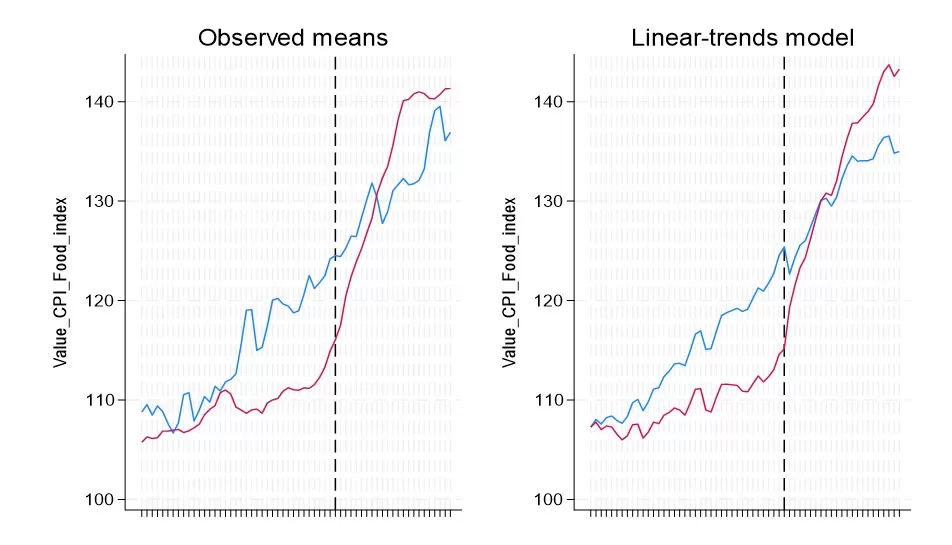
– Treament group – Control group
Graph 1: The trend of the value of the Consumer Price Index For Food And Non-Alcoholic Beverages resulting from DiD
Source: authors’ own research
The Parallel Trends Test performed to check if the trends in the treatment group and the control group were parallel before the intervention (the beginning of the war in Ukraine) obtained the following values: F(1, 1) = 1.29e+17; Prob > F = 0.000.
So, the null hypothesis is rejected, and significant differences exist in how the variable changes before the treatment are applied between the analysis groups (Graph 1).
- b) The consumer price index energy values, see Table 3.
Table 3: The average treatment effect on the treated (ATET) on the consumer
price index of energy in the EU

Source: authors’ own research
The coefficient obtained is 23.40824, and its value demonstrates that the intervention, the outbreak of the war in Ukraine, has significantly affected the value of the consumer price index for energy for the treatment group compared to the control group (Table 2 and Graph 2). More specifically, the average treatment effect in the treated group is higher, with 23.40824, than in the control group. Also, the P> |t| value 0.000 and the confidence level of 95%, as seen in Table 3, demonstrate that the result is significant.

– Treament group – Control group
Graph 2: The trend of the value of consumer price index of energy resulting from DiD
Source: authors’ own research
The Parallel Trends Test, performed to check whether the trends in the treatment group and the control group were parallel before the intervention (the beginning of the war in Ukraine), obtained the following values: F(1, 1) = 7.79e+15; Prob > F = 0.000.
In this way, the null hypothesis is rejected, and there are significant differences in how the variable changes before the treatment is applied between the analysis groups (Graph 2).
Conclusions
In conclusion, according to the results obtained from the difference-in-difference (DiD) statistical technique (Tables 2 and 3 and Graphs 1 and 2), the outbreak of the war in Ukraine, the intervention used in the DiD analysis caused a significant change in the values of the consumer price index for food and non-alcoholic beverages and of the consumer price index of energy in the countries that are part of the treatment group compared to the countries that are part of the control group. These results confirm Hypothesis 1 or the alternative hypothesis.
Although the European Union (treatment group) is not directly involved in the military conflict by deploying its troops in the war area, the EU citizens face significantly more significant economic consequences than citizens from South Korea (control group).
The states involved in the analysis have different attitudes but not the same approach to the perspective of the sanctions and the commercial relations they undertake with Russia (Stangarone, 2024).
The significant increase in the consumer price index for food and non-alcoholic beverages and the consumer price index for energy experienced by EU citizens compared to those in South Korea can also be considered a consequence of the efforts made by the European Union to support, manage, and mitigate the impact of the war in Ukraine on countries that are dependent on exports of Ukrainian products (IfW Kiel Institute For The World Economy, 2024), or that the Asian country is at a considerable distance from the crisis zone.
So, a military crisis like the one in Ukraine that has been going on since February 2022 affects the behavior of consumers of food, non-alcoholic beverages, and energy in countries or alliances that are in the vicinity of the conflict zone and that support peace, freedom, independence, and sovereignty.
Research Limits
Regarding the limits of analysis, it is crucial to recognize that no analysis can be perfect. Certain limitations must be considered in this analysis, such as the availability of data, the mode of aggregation, and the variables omitted from the data set used for the values investigated by the DiD method, respectively.
The study design, which includes the choice of the control group and the group of treatment, the period analyzed, and the robustness of the analysis, also needs to be considered. Nevertheless, it’s important to underscore that the DiD analysis, despite its inherent limitations, still offers substantial insights into the impact of the war in Ukraine on the consumer price index for food and non-alcoholic beverages and the consumer price index of energy. This analysis is particularly significant for the European Union (treatment group) compared to South Korea (control group).
Future Research
For future research on the impact of the war in Ukraine, it is possible to extend the DiD analysis to include a broader range of countries, use micro-level data, and include more variables to reduce confounding and obtain more accurate estimates. In addition, alternative methods such as synthetic difference-in-differences (SIDD) analysis can be explored, or other matching techniques can be attempted to identify a new control group that is more comparable to the treatment group.
Acknowledgement
Part of this research was conducted as a result of Alexandru Mihăiță Ichim’s Erasmus+ mobility at Università Politecnica delle Marche, Italy, from October 2023 till May 2024.
References
- Abay, K.A., Breisinger, C., Glauber, J., Kurdi, S., Laborde, D., Siddig, K. (2023) ‘The Russia-Ukraine war: Implications for global and regional food security and potential policy responses,’ Global Food Security 36, 100675.
- Ahmed, S., Assaf, R., Rahman, M.R., Tabassum, F. (2023) ‘Is geopolitical risk interconnected? Evidence from Russian-Ukraine crisis,’ The Journal of Economic Asymmetries 28, e00306.
- Anghel, V., Jones, E. (2023) ‘Is Europe really forged through crisis? Pandemic EU and the Russia – Ukraine war’, Journal of European Public Policy 30, 766–786.
- Baumert, T., de Obesso, M.M., Valbuena, E. (2020) ‘How does the terrorist experience alter consumer behaviour? An analysis of the Spanish case’, Journal of Business Research 115, 357–364.
- Ben Hassen, T., El Bilali, H. (2022) ‘Impacts of the Russia-Ukraine War on Global Food Security: Towards More Sustainable and Resilient Food Systems?’ Foods
- Blattman, C. (2022). Why We Fight, Viking, Dublin.
- Choi Soo-hyang. (2022). Russian envoy warns of strain in ties with S. Korea following sanctions announcement. Yonhap News Agency [Online], [Retrieved February 22, 2024], https://en.yna.co.kr/view/AEN20220228009800325.
- Columbia University Mailman School of Public Health. (2016) ‘Difference-in-Difference Estimation|Columbia Public Health,’ Columbia University Mailman School of Public Health [Online], [Retrieved February 25, 2024], https://www.publichealth.columbia.edu/research/population-health methods/difference-difference-estimation.
- Da-gyum, J. (2022). ‘S. Korean military commits to stepping up Ukraine support at US-led dialogue,’ The Korea Herald [Online], [Retrieved March 28, 2024] https://www.koreaherald.com/view.php?ud=20220524000676
- Dudziak, M.L. (2012) ‘War Time: An Idea, Its History, Its Consequences’, Oxford University Press USC Legal Studies Research Papers Series No. 12-1, 3–9.
- European Commission. (2024) ‘Cronologie – Răspunsul UE la invadarea Ucrainei de către Rusia’ [Online], [Retrieved February 24, 2024], https://www.consilium.europa.eu/ro/policies/eu-response-ukraine-invasion/timeline-eu-response-ukraine-invasion/.
- European Commission. (2023) ‘EU-Ukraine Solidarity Lanes The Joint Coordination Platform’.
- European Commission, (2024) ‘About us – European Commission,’ [Online], [Retrieved January 18, 2024], https://civil-protection-humanitarian-aid.ec.europa.eu/who/about-echo_en
- European Parliament. (2023) ‘Rusia | Fișe descriptive despre Uniunea Europeană | Parlamentul European.’
- European Union Global Strategy. (2016). ‘A Global Strategy for the European Union’s Foreign And Security Policy,’ Council of The European Union.
- (2024) ‘HICP – monthly data (index),’ Eurostat, [Online], [Retrieved March 29, 2024], https://doi.org/10.2908/PRC_HICP_MIDX.
- (2024). ‘HICP – annual data (average index and rate of change),’ Eurostat, [Online], [Retrieved March 29, 2024], https://doi.org/10.2908/PRC_HICP_AIND.
- Eurostat, (2023) ‘EU imports of energy products – latest developments,’ Eurostat, [Online], [Retrieved December 23, 2023], https://ec.europa.eu/eurostat/statistics-explained/index.php?title=EU_imports_of_energy_products_-_latest_developments.
- Goodhand, J. (1999) ‘From wars to complex political emergencies: Understanding conflict and peace-building in the new world disorder,’ Third World Quarterly 20, 13–26.
- Goyal, R., Steinbach, S., 2023. Agricultural commodity markets in the wake of the black sea grain initiative. Economics Letters 231, 111297; https://doi.org/10.1016/j.econlet.2023.111297
- Gewehr de Paulo, L.L., Guerra de Andrade, J.B.S.O. (2022) ‘Geopolitics of hunger: Geopolitics, human security and fragile state,’ Geoforum 137, 88–93.
- Haggard, S. (2022) ‘South Korea, Ukraine and Russia Part II: The Economic Dimension. Korea Economic Institute of America,’ The Peninsula, [Online], [Retrieved December 5, 2022], https://keia.org/the-peninsula/south-korea-ukraine-and-russia-part-ii-the-economic-dimension.
- Headey, D., Hironven, K. (2022) ‘A food crisis was brewing even before the Ukraine war – but taking these three steps could help the most vulnerable,’ IFPRI: International Food Policy Research Institute, [Online], [Retrieved December 5, 2022], https://www.ifpri.org/blog/food-crisis-was-brewing-even-ukraine-war-%E2%80%93-taking-these-three-steps-could-help-most-vulnerable.
- Heo, U., Roehrig, T. (2016) ‘Review of SOUTH KOREA’S RISE: Economic Development, Power and Foreign Relations,’ Pacific Affairs 89, 451–453.
- Heo, U., Roehrig, T. (2014) ‘South Korea’s Rise: Economic Development, Power, and Foreign Relations,’ Pacific Affairs, 451-453.
- Horowitz, M.C., Stam, A.C., Ellis, C.M. (2015) ‘Why Leaders Fight’, Cambridge University Press, Cambridge.
- Huntington-Klein, N. (2021) ‘The Effect: An Introduction to Research Design and Causality, 1st edition,’ Chapman and Hall/CRC, Boca Raton.
- IfW Kiel Institute For The World Economy. (2024) ‘Ukraine Support Tracker,’ Kiel Institute For The World Economy, [Online], [Retrieved February 16, 2022], https://www.ifw-kiel.de/topics/war-against-ukraine/ukraine-support-tracker.
- Kazdobina, J., Hedenskog, J., Umland, A. (2024) ‘Why the Russo-Ukrainian War Started Already in February 2014,’ Report No. 2.
- Kemmerling, B., Schetter, C., Wirkus, L. (2022) ‘The logics of war and food (in)security,’ Global Food Security 33, 100634.
- Kim, D.-H. (2022) ‘Unilateral sanctions against Russia not under consideration: Cheong Wa Dae,’ Yonhap News Agency, [Online], [Retrieved March 13, 2024], https://en.yna.co.kr/view/AEN20220225004300315.
- Kim Na-Young (2022) ‘Over US$3 million raised in S. Korean donations to Ukraine: Kyiv envoy,’ Yonhap News Agency, [Online], [Retrieved March 13, 2024], https://en.yna.co.kr/view/AEN20220307009200315.
- Koopman, S. (2011) ‘Alter-geopolitics: Other securities are happening,’ Geoforum 42, 274–284.
- Kuhn, A. (2022) ‘South Korea’s immediate neighbors are impacting the military help its giving Ukraine,’ NPR, [Online], [Retrieved March 13, 2024], https://www.npr.org/2022/04/28/1095365240/south-koreas-immediate-neighbors-are-impacting-the-military-help-its-giving-ukra.
- Liadze, I., Macchiarelli, C., Mortimer-Lee, P., Sanchez Juanino, P. (2023) ‘Economic costs of the Russia-Ukraine war,’ The World Economy 46, 874–886.
- Lucas, E. (2014) ‘The New Cold War: Putin’s Russia and the Threat to the West, Third Edition, Revised,’ Martin’s Griffin, New York.
- Lukin, A. (2018) ‘Russia and South Korea: Towards a Strategic Partnership?’, Russia in Global Affairs, [Online], [Retrieved March 28, 2024], https://eng.globalaffairs.ru/articles/russia-and-south-korea-towards-a-strategic-partnership/
- Ministry of Foreign Affairs from Romania (2024) ‘Republica COREEA | Ministry of Foreign Affairs’, Ministry of Foreign Affairs from Romania, [Online], [Retrieved March 29, 2024], https://www.mae.ro/node/2043.
- Ministry of Foreign Affairs from Republic of Korea. (2022) ‘Korea to Provide Additional Humanitarian Assistance to Ukraine View|Press Releases’, Ministry of Foreign Affairs from Republic of Korea, [Online], [Retrieved March 19, 2024], https://www.mofa.go.kr/eng/brd/m_5676/view.do?seq=322061&rpar.
- Morris, S., Tödtling-Schönhofer, H., Wiseman, M. (2013) ‘Design and Commissioning of Counterfactual Impact Evaluations – A Practical Guidance for ESF Managing Authorities,’ European Commision.
- Oh, S. (2022) ‘Ukraine War, Yoon Election Prompt Demands for Foreign-Policy Shift in South Korea,’ Foreign Policy Magazine, [Online], [Retrieved March 28, 2024], https://foreignpolicy.com/2022/04/06/south-korea-ukraine-war-russia-economy-trade-moon-yoon.
- Olszański, T.A., Sarna, A., Wierzbowska-Miazga, A. (2014) ‘The consequences of the annexation of Crimea’, OSW Centre for Eastern Studies, [Online], [Retrieved Octomber 10, 2023], https://www.osw.waw.pl/en/publikacje/analyses/2014-03-19/consequences-annexation-crimea.
- Organisation for Economic Co-operation and Development (OECD), (2024) OECD Statistics,’ Organisation for Economic Co-operation and Development, [Online], [Retrieved March 11, 2024], https://stats.oecd.org/.
- Ørskov, S., Nielsen, B.F., Føns, S., Sneppen, K., Simonsen, L. (2021) ‘The COVID-19 pandemic: key considerations for the epidemic and its control,’ APMIS 129, 408–420.
- Pandey, D.K., Lucey, B.M., Kumar, S. (2023) ‘Border disputes, conflicts, war, and financial markets research: A systematic review,’ Research in International Business and Finance 65, 101972.
- Prohorovs, A. (2022) ‘Russia’s War in Ukraine: Consequences for European Countries’ Businesses and Economies,’ Journal of Risk and Financial Management 15.
- Roehrig, T. (2022) ‘Becoming an “Unfriendly” State: South Korea–Russia Relations and the Invasion of Ukraine,’ Asian Survey 62, 866–892.
- Sang-ho, S. (2014) ‘Crimea crisis could impact Seoul’s diplomacy,’ The Korea Herald, [Online], [Retrieved March 28, 2024], https://www.koreaherald.com/view.php?ud=20140318001479 (accessed 3.28.24).
- Smith, J., Shin, H., 2022. S.Korea to join sanctions against Russia, but not considering unilateral steps. Reuters.
- Stangarone, T. (2024) ‘Even Without Sanctions, South Korea Significantly Reduced Fossil Fuel Imports From Russia’, The Diplomat.
- Tereshchenko, M. (2022) ‘Russian government approves list of unfriendly countries and territories,’ TASS, [Online], [Retrieved March 13, 2024], https://tass.com/politics/1418197.
- The Observatory of Economic Complexity (OEC). (2024) ‘Petroleum Gas in Russia’, The Observatory of Economic Complexity (OEC), [Online], [Retrieved March 29, 2024], https://oec.world/en.
- Tong, E. (2024) ‘Repercussions of the Russia–Ukraine war,’ International Review of Economics & Finance 89, 366–390.
- Trading Economics, (2024) ‘South Korea Exports to Russia – 2024 Data 2025 Forecast 1992-2022 Historical,’ Trading Economics, [Online], [Retrieved March 29, 2024], https://tradingeconomics.com/south-korea/exports/russia.
- Trading Economics (2024) ‘South Korea Consumer Price Index (CPI)’, Trading Economics, [Online], [Retrieved March 29, 2024], https://tradingeconomics.com/south-korea/consumer-price-index-cpi.
- Varaki, M. (2022) ‘How has Russia violated international law?’, Feature from King’s College London, [Online], [Retrieved March 19, 2024], https://www.kcl.ac.uk/how-has-russia-violated-international-law.
- World Integrated Trade Solution (WITS). (2024) ‘European Union Trade | WITS Data’, World Integrated Trade Solution, [Online], [Retrieved February 2, 2024], https://wits.worldbank.org/CountrySnapshot/en/EUN
- World Trade Organization (WTO). (1995) ‘WTO | What is the WTO? – Who we are,’ World Trade Organization (WTO), [Online], [Retrieved March 18, 2024], https://www.wto.org/english/thewto_e/whatis_e/who_we_are_e.htm.


















